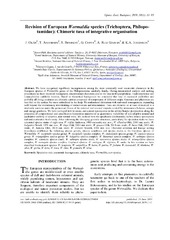| dc.Published | Oláh J, Andersen T, Beshkov S, Coppa G, Ruiz Garcia, Johanson KA. Revision of European Wormaldia species (Trichoptera, Philopotamidae): Chimeric taxa of integrative organisation. Opuscula Zoologica. 2019;50(1):31-85 | eng |
| dc.description.abstract | We have recognised significant incongruences among the most commonly used taxonomic characters in the European species of Wormaldia genus of the Philopotamidae caddisfly family. During taxonomical analysis and ranking procedures we have recorded incongruent, discorcordant characters also in the taxa in Rhyacophilidae, Hydropsychidae and Limnephilidae caddisfly families. Based on theoretical background we concluded that taxa of examined caddisflies and probably all living creatures are chimeric entities composed of components of different origin. Genomes and phenomes are tree-like on the surface but more reticulated in the deep. We understand chimerism with universal consequences, expanding well beyond the evolutionary tree-thinking of reductionism and determinism. Taxa are chimeric or at least chimerical in a stochastic universe under the permanent fluxes of the external and internal impacts created by intercourses between entropy and energy gradients. We have surveyed how to create and correct synonymies in the splitter/lumper perspectives along the principles of compositional and specification hierarchies understood as quantitative variability of non-adaptive neutral and qualitative stability of adaptive, non-neutral traits. We outlined how the apophantic (declaratory) hybris creates synonymies and underestimates biodiversity. After redrawing the diverging genitalic structures, particularly the speciation traits we have reinstated species status of eight taxa: W. trifida Andersen, 1983 stat.restit, stat. nov., W. albanica Oláh, 2010 stat. restit., W. bulgarica Novak, 1971 stat. nov., W. daga Oláh, 2014 stat. restit., W. graeca Oláh, 2014 stat. restit., W. busa Oláh, 2014 stat. restit., W. homora Oláh, 2014 stat. restit. W. nielseni Moretti, 1981 stat. nov. Character selection and lineage sorting procedures established the following species groups, species complexes and species clades in the European species of Wormaldia: W. occipitalis species group: W. occipitalis species complex; W. charalambi species group; W. copiosa species group; W. triangulifera species group: W. bulgarica species complex, W. khourmai species complex, W. subnigra species complex: W. asterusia species clade, W. subnigra species clade, W. vercorsica species clade; W. triangulifera species complex, W. variegate species complex. Unplaced species: W. ambigua, W. algirica, W. sarda. In this revision we have described fourteen new species: W. longiseta, W. carpathica, W. kurta, W. parba, W. foslana, W. kumanskii, W. libohova, W. silva, W. gorba, W. kera, W. rona, W. sima, W. granada, W. telva. | en_US |

